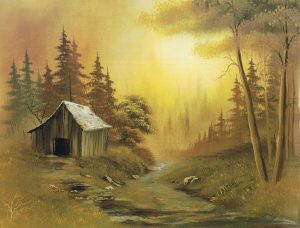The section that I will be covering in Green Grass, Running Water is the introduction of Eli Stand Alone with the focus upon on his role in the story: standing his ground by literally remaining inside his mothers house to stop the operation of the dam. The theme that is illustrated in these few pages and through Eli in the story is the characters self-journey to find themselves and in this instance to for Eli to find himself circulating back to his roots through the metaphor of water (dam).

Eli Stand Alone
Eli Stand Alone’s name is important when looking at his surname. Stand Alone as Jane Flick explains is suggested to reference Elijah Harper, the man who stood his ground and fought against the Meech Lake Constitutional Accord in 1990. He blocked the operation of this by being the standout vote in the Manitoba legislature. Stand Alone follows Harper’s actions by standing up against the government in their action to operate the dam that would ultimately tear down his mothers home; the home she built with her own hand; the home that Eli and his siblings grew up in, created memories; and the home that overall brings Eli back to his roots. The last name Stand Alone works to elucidate the physical aspect of Eli standing alone to prevent the dam from happening, it is only he who reside in the home without help from his siblings.
The blocking of the dam is another display of the differences between the values of the Government (westernized thinkers) and those of the First Nations. Eli argues with the question: “how come so many of them [(dams)] are built on Indian land?” (King 111). The geographical location of this damn, when it is made clear there were other options, is an example of the Government’s belief that First Nation land is not equally valuable to land which is not. The fight between Eli and Clifford Sifton (who represents the Government), the man in charge of operating the dam is clearly shown to an endless battle with neither side listening. “Eli shouted, thought he knew Sifton couldn’t hear him above the rush of the water. Sifton raised his walking stick and shouted back, but Eli couldn’t hear him either.” (110) this moment between these two men illustrates the way in which values, beliefs, superiority, laws and regulations prevent each side from clearly hearing the voice of the other.
It is also important to note that the lake Eli Stand Alone is working to protect is named Parliament Lake which is no coincidence. Stand Alone is fighting against an operation that is run by the government and overall on a lake named after the highest legislature, it foreshadows that this fight will not be easy.
Clifford Sifton
I wanted to continue looking at this scene between Eli and Clifford. But before I provide more evidence, it is necessary to look at Flick’s notes on this character. Flick points out that Sir Clifford Sifton was an aggressive promoter of settlement in the West. This aggressive nature that is connected to Sifton is physically demonstrated through the act of forcibly pushing through the water to get to Eli. “The water buffeted Cliff’s legs, and Eli could see the man rocking and balancing as he stepped from rock to rock” (110) the water doesn’t make it easy for Clifford. The water acts as another force against the Government and a parallel to the aggressiveness Sifton is associated with as the water aggressively pushes against Clifford.
Looking again at the moment where neither Eli or Clifford can hear one another over the water not only demonstrates the stubbornness and the ethnocentrism that is definitely seen within the White culture, and possibly within Eli’s belief of his culture and traditions, but is also an ironic moment. It is ironic because the Sir Clifford Sifton Flick discusses in her notes suffered from deafness his entire life. Once again King does not do coincidences. King’s choice in Sifton, as the man that symbolizes everything Eli (The Indians) are fighting against, to be Deaf is crucial in the demonstration that the Government’s ears are closed to those who do not run with them. Of course Sifton cannot choose to not be Deaf, but I think it displays a stronger impact in the denial that The government have upon choosing this land to build a dam on. In other words, Sifton hears what he wants to hear, and thus the Government will find ways to move forward in this fight, whatever the means.
It is also important to know that Sir Clifford Sifton was part of the building of the Canadian Pacific Railway. A job that was only completed by the forced slavery of thousands of imported Chinese Workers. This fact is important in understanding that the Sifton Jane discusses was a man that placed himself as superior; in charge of a project that placed the imported Chinese workers as inferior and worthless, brutally treating them in harsh working conditions and paying them little for their great work.I believe that King hopes that the reader is able to connect the two Siftons and in doing so can realize the possibility that the story’s Sifton will do anything in order to complete the damn, just like Sir Clifford Sifton does to complete the Canada Pacific Railway: using slaves. It leaves the reader wondering: if the earthquake did not break the dam, at what lengths would Sifton have gone to in order to force Eli to step down? Would he have gone so far and as inhumanely as Flick’s Sifton does in the creation of the Canada Pacific Railway?.
Blossom
Blossom is the town that the story centers around and it is important in “the natural beauty and regeneration, and the smallness” that the name represents as suggest by Jane Flick. For a novel that structure mirrors its content; all of the Native American characters grappling with the balance of tradition and modernity, Blossom works to in a minute but beautiful way to coincide with this struggle. The characters are on journey of self-finding, and as discussed earlier, Eli’s journey leads him back to his roots. Regeneration is altered within Eli’s story as he reverses it, rather than moving forward to create a new him, he turns back to what he knows to regenerate the generations before him. If we are to think of the first thing that comes to mind when hearing the word blossom, a flower appears. Flowers blossom every year, and each year they differ a little depending on the location of pollination that must occur. In a sense King’s characters only blossom, in other words, find themselves when they relocate themselves to where they want to be. It could be said that the characters ultimately represent pollen and thus move to blossom. This is a far fetched idea but I like the connection here between man and nature.
Works Cited
Flick Jane. “Reading Notes for Thomas King’s Green Grass, Running Water.” Canadian Literature 161/162 (1999). Web.
Gall, Gerald L. “Meech Lake Accord.” The Canadian Encyclopedia, Historica Canada, 7 Feb. 2006, www.thecanadianencyclopedia.ca/en/article/meech-lake-accord/.
Hall, David J. “Sir Clifford Sifton.” The Canadian Encyclopedia, Historica Canada, 22 Jan. 2008, www.thecanadianencyclopedia.ca/en/article/sir-clifford-sifton/.
Lavallé, Omer. “Canada Pacific Railway.” The Canadian Encyclopedia, Historica Canada, 6 Mar. 2008, www.thecanadianencyclopedia.ca/en/article/canadian-pacific-railway/.n/
King, Thomas. Green Grass, Running Water, Harper Perennial, Toronto, Ont, 2007.


 .
.



